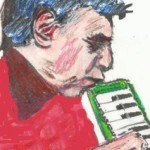The First Hohner Melodica and Clones
Tagged: the dating game
- This topic has 24 replies, 10 voices, and was last updated 4 years, 2 months ago by
 Michael.
Michael.
-
AuthorPosts
-
August 23, 2016 at 9:32 pm #7546
 Alan BrintonParticipant
Alan BrintonParticipantI have indicated in another thread that I think priority for identification of the first melodica (generic “melodica”) should go to the Borel’s Clavietta, introduced in 1958. Hohner’s first Melodica was also introduced in 1958. Two reasons for according the title to the Clavietta are (1) The Hohner Soprano appears to have been first announced in early December, 1958, while it seems likely that the Clavietta was introduced earlier in the year (though the evidence I have seen is inconclusive); (2) The Clavietta was a much more sophisticated instrument and had the piano style keyboard that has subsequently been established as the standard. The 1958 Hohner Soprano was a button style instrument. It has been said that Hohner invented the melodica in 1953, but my research has not clarified that claim; Hohner research that led up to the 1958 green button Soprano was probably underway in 1953, but by then Borel’s button Accordina was in production before then and had been conceived much earlier.
The 1958 Hohner Soprano was, however, a very important and influential innovation. In 1959, harmonica maker Manji Suzuki acquired one and, according to company history, was inspired to create a version with a piano style keyboard, in the hope (later realized) that his instrument, the Melodion, could be used to satisfy the Japanese ministry of education requirement that all school children learn to play both a wind instrument and a keyboard instrument. Suzuki apparently was unaware that such an instrument had already been created by Andre Borel. Suzuki’s Super-34 appeared in 1961. But company documents show for 1960 button style instruments that look very much like the 1958 Hohner button style Soprano and subsequent Alto.
I wondered for a long time whether these 1960 Melodions were ever actually manufactured. Eventually, I was able to acquire one, a soprano. It might have been a proto-type, or maybe there was a very limited production run. It is nearly identical to the green Hohner Soprano. Very recently, I was surprised to find another clone of the Hohner Soprano, the Sae Chang Soprano. Sae Chang is a South Korean musical instrument company. I’m not sure what the original case was for the Hohner Soprano, but the cases for the Suzuki and the Sae Chang are very similar. On the other hand, the Sae Chang is identified on its case as a melodica, not as a Melodion. South Korean issues of Suzuki models have commonly been identified as Melodions. So I have no idea whether the Sae Chang is a copy of the Hohner or of the Suzuki or of both. Here are photos, of the three, side by side, and of their cases.
August 23, 2016 at 9:44 pm #7547 Alan BrintonParticipant
Alan BrintonParticipantSound: It’s hard to make comparisons, as only the Hohner plays reasonably well. But tonally the Suzuki sounds like the Hohner, though its sound is more jagged, not as smooth. The Sae Change is so leaky that it barely plays, and the sound is noticeably inferior to the other two, uneven and harsh.
August 25, 2016 at 1:26 pm #7563 Shannon MParticipant
Shannon MParticipantHi Alan,
Does the range on the Suzuki begin higher or lower than the Hohner?
Regards,
Shannon
August 25, 2016 at 1:38 pm #7565 Alan BrintonParticipant
Alan BrintonParticipantThe Suzuki begins higher.
August 25, 2016 at 11:08 pm #7567 DarenKeymaster
DarenKeymasterThis is fascinating info Alan, thanks for sharing your research. So it appears Hohner has an important historical role, even if it does fall short of its claim to have ‘invented’ the (generic) Melodica.
March 21, 2017 at 6:34 pm #8732 Alan BrintonParticipant
Alan BrintonParticipantBruno, who is a reliable authority on what’s inside his melodicas, informed me that he has a Hohner Professional 36 that inside bears the date “1958.” Whether that means that the Professional had actually entered the market by then or not, it looks like we have more or less a tie between Borel and Hohner for “First Melodica.”
March 22, 2017 at 2:55 am #8733 jazzman1945Participant
jazzman1945ParticipantMelodica history
Die Geschichte der Melodica
In den 1950er Jahren wurde bei Hohner die Entwicklung eines neuen Musikinstrumentes vorangetrieben, welches die Anforderungen der musikalischen Früherziehung optimal befriedigen und die Nachteile der damals gebräuchlichen Instrumente (v.a. Blockflöte) überwinden sollte.
Es war ein optisch attraktives Instrument mit großer musikalischer Ausdrucksfähigkeit gewünscht. Ideengeber und „Väter“ der Melodica sind nicht eindeutig zu ermitteln. Nach Aussagen von Zeitzeugen resultierte die erste Form der Melodica aus einer Zusammenarbeit der Hohner-Musterwerkstatt mit der Abteilung Metallbau-Akkordeon unter Dr. Dorner.
Im November 1958 schließlich konnte die Neuschöpfung erstmals in der Hohner-Verkaufsinformation präsentiert werden – Die SOPRANO MELODICA.
Das Instrument mit den „Stummeltasten“ aus der Familie der Blasharmonikas lässt den eingeblasenen Luftstrom durch Drücken einer Taste in eine Kanzelle fließen, wodurch eine Stimmzunge in Schwingung gerät. Da der Luftstrom durch eine „Einbahnstraße“ fließt, lässt sich der Ton nur durch Einblasen und nicht wie bei der diatonischen Mundharmonika auch durch Ansaugen erzeugen. Durch das Drücken mehrerer Tasten ist die Melodica leicht polyphon spielbar.
Im ersten Halbjahr der Produktion wurde der Stimmstock aus Birnenholz gefertigt, dann jedoch stellte man auf Spritzgussteile um, weil es nachhaltige Probleme mit aufquellendem Holz gegeben hatte. Die Spritzgussform wurde in der Firma unter Ingenieur Kurt Mast entwickelt.
Da man die Anlehnung an eine vollwertige Klaviertastatur suchte, die die Akzeptanz der Melodica als Vorinstrument für Akkordeon und andere Tasteninstrumente ermöglichen sollte, wurde fieberhaft an der Weiterentwicklung gearbeitet. Tatsächlich – im Jahr 1961 folgten in dieser Weise erweiterte Modelle – die PIANO MELODICAS. Maßgeblich beteilig bei der Entwicklung dieser „erwachsenen“ Melodica war der Instrumentenbauer und Hohner-Mitarbeiter Franz Lindermaier. Im USA-Patent von 1962 wird er namentlich als Erfinder erwähnt.
Es folgten zahlreiche weitere Neuerungen wie beispielsweise die Bass Melodica, die Melodica Cassotto, die heute noch beliebte Clarina (mit nur 8 Tasten) oder die skurrile Hohner ELECTRA MELODICA (erste Präsentation 1967) mit 6 verschiedenen Registern, mit welchen verschiedene Instrumente wie Klarinette, Blechbläser, Streicher oder Flöte simuliert werden, sowie bei Bedarf Vibrato und Wah-Wah Effekte hinzugeschalten werden konnten.
Noch 1975 wurde die Anzahl der Melodica-Spieler in der Bundesrepublik mit einer Million angegeben (im Vergleich: damals spielten etwa 4,3 Millionen Menschen in Deutschland Blockflöte).
In den 1980er Jahren verebbte die Nachfrage nach diesem Instrument zusehends. Elektronische Bauteile wurden immer kleiner und billiger, sodaß alsbald Synthesizer und Home-Keyboards den Massenmarkt dominierten und die Melodica aus den Kinderzimmern verdrängten. Bis Ende der 1990er Jahre führte die Melodica ein Schattendasein und galt vornehmlich als altmodisches Spielzeug für Kinder.
Die MelodicaMarch 22, 2017 at 2:27 pm #8735 DarenKeymaster
DarenKeymasterAlan, this is potentially groundbreaking! Is there any chance of a photo from Bruno for verification?
Jazzman, thanks for this info, I’ve made a google-based translation below. Where is this from? Is it from Hohner? Interestingly, it says that the first Hohner melodica was the button Soprano in 1958, followed by the piano melodicas in 1961. This would go against the idea of a Pro 36 being made in 1958…
Translation:
The History of Melodica
In the 1950s, the development of a new musical instrument was advanced at Hohner, which would ideally meet the requirements of musical early childhood and overcome the disadvantages of the then-common instruments (e.g. recorder).
A visually attractive instrument with great musical expressiveness was desired. The authors of the ideas and the “fathers” of Melodica cannot be clearly identified. According to Zeitzeuge, the first form of Melodica resulted from a collaboration of the Hohner-Musterwerkstatt with the department of metal construction accordion under Dr. Dorner.
In November 1958 the new creation was presented for the first time in the Hohner sales information – The SOPRANO MELODICA.
The instrument with the “stump keys” from the family of the Blasharmonikas lets the blown air flow into a channel by pressing a button, whereby a reed is vibrated. Since the airflow flows one-way, the sound can only be produced by blowing in and not by suction, as in the case of the diatonic harmonica. By pressing several keys, the Melodica is polyphonic.
In the first half of the production, the soundboard was made of pearwood, but they then switched to injection molded parts because of the persistent problems with swelling of the wood. The injection mold was developed within the company under engineer Kurt Mast.
Since one wanted to lean on a full-fledged piano keyboard, which should allow the acceptance of melodica as a pre-instrument for accordion and other keyboard instruments, feverish progress was developed. In fact, in 1961 extended models followed in this way, the PIANO MELODICAS. The instrument builder and Hohner employee Franz Lindermaier played a decisive role in the development of this “adult” melodica. In the United States patent of 1962, he is mentioned as an inventor.
There followed numerous other innovations such as the bass melodica, the Melodica Cassotto, today’s popular Clarina (with only 8 keys) or the whimsical Hohner ELECTRA MELODICA (first presentation 1967) with 6 different registers, with which various instruments such as clarinet, brass , Strings or flute, as well as the use of vibrato and wah-wah effects.
In 1975 the number of Melodica players in the Federal Republic was reported as one million (in comparison, at that time about 4.3 million people played recorder in Germany).
In the 1980s demand for this instrument ebbed. Electronic components were becoming smaller and cheaper, so that synths and home-keyboards soon dominated the mass market and pushed the melodica out of the children’s rooms. Until the end of the 1990s, Melodica was a “shady woman” and was mainly considered an old-fashioned toy for children.March 22, 2017 at 2:29 pm #8736 DarenKeymaster
DarenKeymasterBelow is text from the Hohner website. It also says the 1958 melodica was the soprano button:
HOHNER –
The original inventor of the Melodica
More than 50 years ago HOHNER invented the Melodica. This new musical instrument was intended to ful ll the special demands of early music education.In November 1958 a German language brochure presented this creation for the rst time – the Soprano Melodica with its original stump keys. In 1959 the Melodica was successfully introduced internationally and soon established itself as one of the world‘s most popular beginner ́s instrument.
Very soon professional musicians also discovered the charm of Melodica ́s unique sound. This led to the release of the Piano Melodica in 1961. In 1975 it was estimated that one million people played the Melodica in Germany alone.
Today the Melodica is experiencing a renaissance. It requires no socket, so you can take it with you and play it anywhere. The Melodica has a unique, natural sound which is held in high regard by traditional pop and jazz musicians as well as young alternative bands and experimental artists. More than 55 years after its introduction, the melodica is still the ideal companion for beginners and professional alike who cherish a full, natural sound as well as a wide range of expression, playing comfort, and independency.March 22, 2017 at 3:10 pm #8738 Alan BrintonParticipant
Alan BrintonParticipantThanks to both Jazzman and Daren. The information I have been able to obtain in the past all squares with the story that is told by these two quotations.
As you know, Daren, I started working on a sketch of the history of the melodica a couple of years ago, with your encouragement. It turned out to be so ope-ended and with so many uncertainties, that I eventually set it aside and devoted my energy to collecting and making contributions about particular models in the Vintage Melodicas Forum.
However, I have an unfinished draft, which I will send you today, also to Jazzman if I have his email address. It was getting too speculative in places and I’m sure needs corrections.
Bruno will see this conversation. Maybe he’ll send a photo. I take his word for it, though, and think that it’s possible that his Pro 36 was actually produced in 1958, though it might be that it was just in development then and the dated part was being made. Some of what goes on (has gone on) at Hohner is known only to insiders. Bruno has also found some more recent information about this, though, as a member of an international spy ring, he’s close with his sources. In the public Hohner information and advertising, there is almost nothing about the Professional 36, up into the 1960s and later, and I have been able to find nothing about the Soloist, though we know from Oscar that it exists. There is evidence that the Professional was in existence in the early 1960s, 1961 if memory serves here — I think I have something or saw something. But no mention of it by Hohner at that time, that I know of. So the fact that Hohner statements about 1958 make no mention of it doesn’t mean much to me.
March 22, 2017 at 6:32 pm #8739 jazzman1945Participant
jazzman1945ParticipantDarren, thanks for the translation! This material I have received from the representative of company Honer Sabine Olbricht 7 years ago.
Melodica infoMarch 23, 2017 at 6:45 am #8741 Melodica-MeParticipant
Melodica-MeParticipantI was very curious about the date of 1958 for the Professional 36 and decided to check the date on one of (3) I own. In black stamped letters it says 16 Marz 1962, I will check the others this weekend and see if the dates are the same. I do not see any other dates listed inside the Melodica.
Melodica-MeMarch 23, 2017 at 5:30 pm #8742 Alan BrintonParticipant
Alan BrintonParticipantI just inspected one of my (2) Professionals that is apart, and there is no date, since it was on gasket material that I have stripped off. Fortunately, I had photographed it earlier:
I’m guessing that the “041262” signifies 4 December 1962. Ofir thought he read a 1952 date on his Professional, but I think that was actually “62”. In fact, his photos show two dates, the other one being a March 1962 date.
It is noteworthy that the date is stamped on the gasket strip, which suggests that it was dated when the instrument was being put together.
March 23, 2017 at 7:37 pm #8743 Melodica-MeParticipant
Melodica-MeParticipantHere is a picture of the one I opened last night
Melodica-Me
March 24, 2017 at 1:43 pm #8758 LowboyParticipant
LowboyParticipantExcluding synthesizers and low production novelty instruments, this makes the melodica a very modern instrument. No?
Lowboy
-
AuthorPosts
- You must be logged in to reply to this topic.








